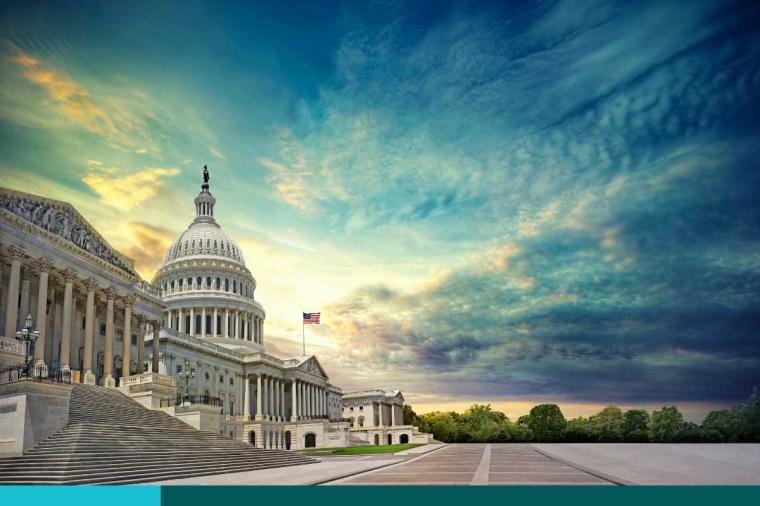A Tale of Two Budgets: FY24’s Status and What’s Next for IT in FY25

If you have been confused lately seeing multiple March dates with some mention of the federal budget tied to them, you are not crazy. There are in fact multiple budgets floating out there in the ether: some finalized versions for certain agencies, others still awaiting that vote and presidential approval for fiscal year 2024 (FY24), as well as a wholly new request for funding from the President for FY25 priorities. We will catch you up as succinctly as possible, and if FY24 sounds too confusing, read on to hear what’s catching attention across IT for FY25.
FY24
FY24 started on October 1, 2023. Since that date, we have been operating on mostly FY23 levels thanks to a run of continuing resolutions (CR) up until, and continuing past, March 8, 2024. That day, however, marked the passing of minibus for six appropriations bills, including Agriculture, Commerce-Justice-Science, Energy-Water, Interior-Environment, Military Construction-Veterans Affairs, and Transportation-Housing and Urban Development. According to the Committee for a Responsible Federal Budget:
The first set of appropriations bills that were scheduled to expire under the CR have now been funded through September. The second set of appropriations bills are scheduled to expire on Friday, March 22 – Defense, Financial Services-General Government, Homeland Security, Labor-HHS-Education, Legislative Branch, and State-Foreign Operations. Under the agreement, leaders planned to complete full-year appropriations for the remaining bills by the end of the current CR.
The current CR they are speaking of, the fourth to be issued since the beginning of FY24, ends March 22. The government could issue one more continuing resolution, but if an agreement is not reached by April 30, 2024, a one percent decline in spending will be issued as a result of the previously signed debt ceiling agreement. What is that agreement in one sentence, you ask? In June 2023, President Biden signed the Fiscal Responsibility Act, reducing both defense and nondefense funding levels by one percent if appropriations bills are not enacted in a given timeframe. That timeframe deadline was January 1, 2024, but thanks to a sequestration order, the final deadline is at the end of April 2024 instead.
So that is where we stand with funding in FY24. Some bright(er) spots with movement, and more we continue to wait on. In the middle of all this, the President released the FY25 budget request. We will look next at the top-level numbers, and some highlights for IT companies to watch as well.
FY25
Amid the backdrop of threats and global uncertainties from China, Russia and potential aid to Ukraine, Israel and Taiwan creating a complex web of variability, is the top line amount requested for FY25 at just over $1.6 trillion in discretionary funding. $850 billion was requested by the Pentagon, and drilling down on the other side of the house, we also know at this point that civilian agencies are hoping for just over $75 billion targeted solely to IT pursuits. There is approximately $13.1 billion in the budget for civilian cybersecurity-related activities, and another estimated $14.5 billion for the Department of Defense’s (DoD) cyberspace spending objectives.
A lot of numbers there. A lot of tech-focused money, even given the threat of cuts. Where is it all going? I’m glad you asked.
Show Me the IT Money
For FY25, the following are IT priorities highlighted in the budget that will see funding-backed attention: cybersecurity, artificial intelligence (AI), IT modernization, a Digital-First Experience, and the use of data as a strategic asset.
The push toward a zero-trust architecture (ZTA) continues to frame cybersecurity needs in the 2025 request. With the 2027 deadline approaching, agencies will focus on the pillars outlined for zero trust from the administration. Investment will also follow the National Cybersecurity Strategy’s guidance, including efforts that defend critical infrastructure; disrupt and dismantle threat actors; shape market forces to drive security and resilience; invest in a resilient future; and forge international partnerships to pursue shared goals.
AI investment will focus on the need primarily for the security of all that artificial intelligence has to offer, with $300 million dedicated to those pursuits, as well as an additional $40 million to fund personnel and talent acquisition for agencies to be able to hire additional personnel with applicable skills. On the heels of the previously issued AI Executive Order 14110 and corresponding Office of Management and Budget (OMB) AI memo, it is clear that any technologies industry brings to agencies will need to have security baked-in and part of the overall planned architecture. As an IT company, you will want to lead your conversations around AI to agencies with an automatic nod to how the data and the overall AI technology will be safeguarded against eventual threat actors.
Next atop the list of tech priorities is IT modernization. Same story, different year here. Agencies have long been attempting to sunset legacy systems and update. In FY25, that purports an additional $75 million infused into the Technology Modernization Fund (TMF) toward employing methods of continuous improvement and scaling them across agencies for continued modernization needs. Think modernizing high priority systems, strengthening the cybersecurity of federal agencies, and improving public-facing digital products and services.
The push for IT companies to help agencies embrace what the government terms a Digital-First Experience will continue gaining traction this coming fiscal year as well. It refers to policies outlined in the previously issued Executive Order 14058, in conjunction with OMB memo M-23-22, with emphasis on funding to deduplicate web content, modernizing the front-end design of websites and digital services, and improving the accessibility of websites and digital services. Companies who play in this space will want to pay close attention to efforts stemming from this pocket of funds.
Last but not least in the areas we will see pockets of IT spending in FY25 is arguably what drives so many technologies in the first place: data. The federal government will be prioritizing the continued roll out of action plans from the Federal Data Strategy, originally published in 2019. This includes the proper acquisition and secure usage of data to inform actionable decisions across agencies. There will continue to be a need for technologies that scrub and provide clean data for all agencies for years to come.
There you have it: these are the top IT areas we are likely to see the most funding poured into in FY25. Again, we wait for the (eventual) passage of the final budget. And this year, grab popcorn because there is not one, but two fiscal years’ bills still in line for that final stamp of approval.
To get more TD SYNNEX Public Sector Market Insight content, please visit our Market Intelligence microsite.
About the Author:
Susanna Patten is a senior analyst on the TD SYNNEX Public Sector Market Insights team covering tech domain centric trends across the Public Sector.




























